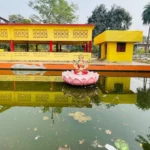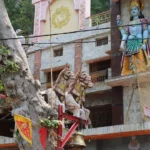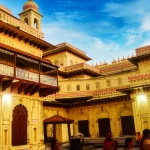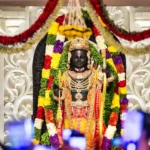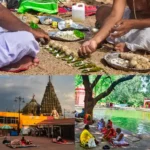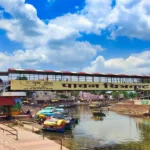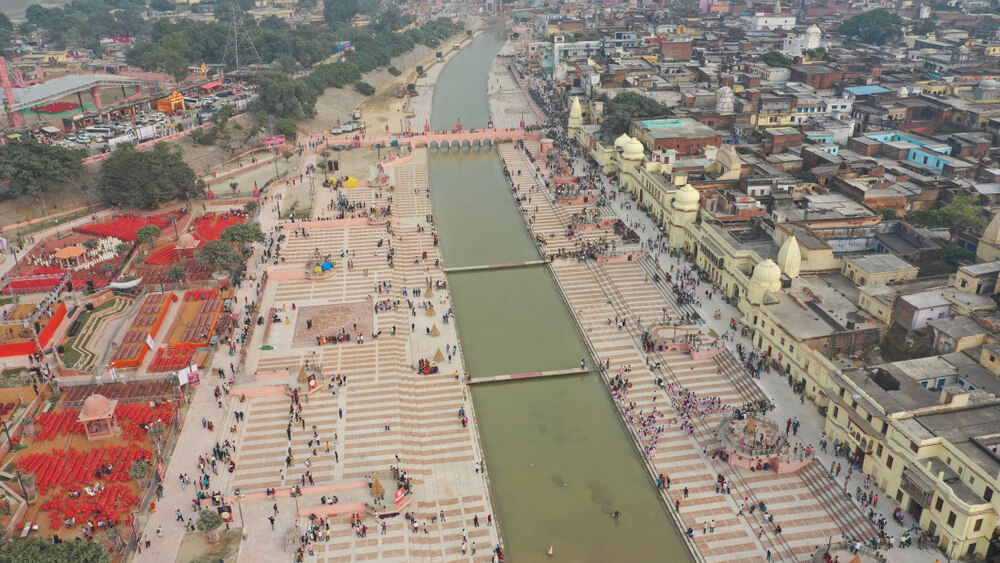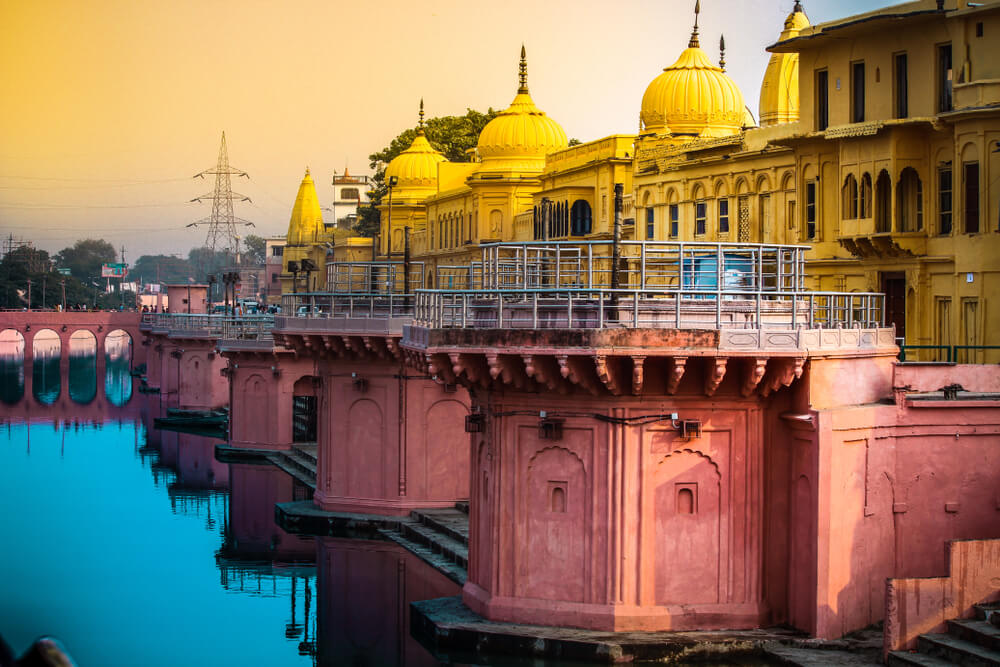Visitor Experience: Immersing in the Spiritual Aura of Ram Ki Paidi
Unforgettable Moments at Ram Ki Paidi
The experience of visiting Ram Ki Paidi is an immersion into a world where spirituality, history, and natural beauty converge. Each visitor to this sacred site embarks on a unique journey, finding moments of peace, reflection, and joy in the serene ambience of the ghats.
Spiritual Awakening:
The experience of taking a dip in the holy waters of the Sarayu River at Ram Ki Paidi is often described as transformative. Pilgrims believe that these waters have the power to cleanse not just the physical body but also the soul, offering a sense of renewal and spiritual awakening.
Visitors often express a profound sense of connection with the divine, an experience heightened during the morning and evening aartis. The sound of bells, the chanting of prayers, and the rhythmic clanging of cymbals create a mesmerizing atmosphere that deeply resonates with devotees and tourists alike.
A Visual Spectacle:
The night view of Ram Ki Paidi, especially during festivals like Deepotsav, is nothing short of spectacular. The reflection of thousands of diyas on the Sarayu River creates a magical landscape, enchanting visitors with its ethereal beauty.
Reviews from travellers often highlight the breathtaking sight of the ghats lit up during these celebrations, emphasizing the visual grandeur and the vibrant energy that Ram Ki Paidi exudes during such occasions.
Cultural Exploration:
Beyond its spiritual significance, Ram Ki Paidi offers a rich tapestry of cultural experiences. The surrounding areas are dotted with temples, markets, and eateries, allowing visitors to delve into the local culture and traditions of Ayodhya.

Many visitors take the opportunity to explore nearby historical and religious sites, making their visit to Ram Ki Paidi a comprehensive cultural and spiritual journey.
Conclusion:
A visit to Ram Ki Paidi is more than just a sightseeing trip; it’s an opportunity to partake in a living tradition, to feel the pulse of Ayodhya’s spiritual heart. Whether one seeks solace, wishes to partake in religious rituals, or simply wants to experience the cultural richness of this ancient city, Ram Ki Paidi offers an experience that stays with you long after you’ve left its sacred steps.
Accessibility and Facilities: Navigating and Experiencing Ram Ki Paidi with Ease
Ease of Access to Ram Ki Paidi
One of the aspects that make Ram Ki Paidi a popular destination is its accessibility. Situated in the heart of Ayodhya, the ghats are well-connected and easy to reach for visitors coming from different parts of the country.
Reaching Ram Ki Paidi:
By Road: Ayodhya boasts a well-maintained network of roads, making it easily accessible by bus or car. Regular bus services connect Ayodhya to various cities in Uttar Pradesh and neighbouring states, ensuring a convenient journey for visitors travelling to Ram Ki Paidi.
By Rail: Ayodhya is well-served by two railway stations – Ayodhya Junction and Ayodhya Cantt. These stations are connected to major cities and towns across India, making train travel a viable option for reaching Ram Ki Paidi.
By Air: For those preferring air travel, the nearest airports are in Lucknow and Gorakhpur. From these airports, visitors can take a train or bus, or hire a taxi to reach Ayodhya and subsequently, Ram Ki Paidi.
Facilities at Ram Ki Paidi:
Accommodation: Visitors will find a range of accommodation options in Ayodhya, from budget lodges to more comfortable hotels, catering to different preferences and budgets.
Changing Rooms and Amenities: Recognizing the needs of the thousands of pilgrims and tourists who visit, Ram Ki Paidi is equipped with adequate facilities such as changing rooms for men and women, ensuring a comfortable experience for those taking a dip in the Sarayu River.
Safety Measures: The local authorities and management of Ram Ki Paidi place a high priority on the safety and security of visitors. Regular maintenance of the ghats, along with the presence of safety personnel, ensures a secure environment.
Culinary Delights and Shopping:
Ayodhya, the city that houses Ram Ki Paidi, offers a delightful culinary experience with a variety of local cuisines. Visitors can enjoy traditional dishes and street food, adding another dimension to their visit.

The area around Ram Ki Paidi also features a range of shops selling religious artefacts, souvenirs, and local handicrafts, allowing visitors to take a piece of Ayodhya’s spiritual and cultural heritage back home with them.
Conclusion:
Visiting Ram Ki Paidi is made easy and enjoyable thanks to the well-planned infrastructure and facilities in and around the area. Whether it’s the journey to the ghats, the stay in Ayodhya, or the experience at the ghats themselves, visitors are well catered for, making their trip to Ram Ki Paidi a memorable one.
Conclusion: Embracing the Essence of Ram Ki Paidi
Ram Ki Paidi: A Journey Beyond the Ordinary
As our exploration of Ram Ki Paidi comes to a close, it’s clear that this sacred site in Ayodhya is much more than a series of ghats along the Sarayu River. Ram Ki Paidi represents a profound journey into the heart of India’s spiritual and cultural heritage, offering a unique experience that stays with visitors long after they have left its shores.
A Spiritual Beacon:
Ram Ki Paidi serves not only as a place of worship but also as a beacon of spiritual enlightenment. It’s a space where history, mythology, and tradition intertwine, providing a deep sense of connection to the past and a renewed understanding of one’s spiritual self.
The experience at Ram Ki Paidi, from the tranquil baths in the holy waters to the grandeur of the Diwali celebrations, is a testament to the site’s enduring spiritual significance and its ability to captivate the hearts of those who visit.
A Cultural Tapestry:
Beyond its spiritual allure, Ram Ki Paidi is a vibrant tapestry of culture and tradition. It is a place where the rituals of the past meet the celebrations of the present, creating a living, breathing representation of India’s diverse cultural landscape.
The ghats of Ram Ki Paidi are not just steps leading to the river but steps into a world rich with stories, legends, and faith, offering a glimpse into the soul of Ayodhya and, by extension, India.
Invitation to Experience:
In conclusion, Ram Ki Paidi invites you to experience not just a physical destination but a journey of spiritual discovery and cultural immersion. Whether you are a pilgrim, a history enthusiast, or a curious traveller, Ram Ki Paidi offers a unique and enriching experience that resonates with the vibrancy and depth of India’s heritage.

As you plan your visit to Ram Ki Paidi, remember that you are not just visiting a location; you are stepping into a realm of spiritual significance, cultural richness, and historical depth that is unparalleled.
Discover the Spiritual Essence of India with Prayag Samagam!
Embark on an enlightening journey through the sacred lands of Ayodhya and beyond. Dive into the rich tapestry of Indian spirituality and culture with our expertly curated content and travel guides. Whether you’re seeking a deeper understanding of the historical Ram Ki Paidi or looking to explore the spiritual wonders of India, Prayag Samagam is your ultimate guide.
Don’t miss out on our latest articles, travel tips, and insights into India’s spiritual heritage. Visit Prayag Samagam now and start your journey towards spiritual enlightenment and cultural discovery!
Explore. Discover. Connect. With Prayag Samagam.











